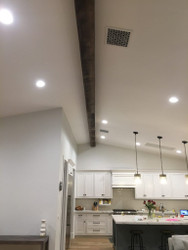
Our custom beams are available up to 30 feet long, but what happens when your project requires a super large beam?
We've often mentioned how our beams are actually superior to their real wood counterparts. There are a variety of reasons why - affordability, easy installation and their incredible versatility thanks to their lightweight, customizable design. But today we got sent a project photo that identified one of the other key reasons why 'going faux' is the best option for installing a faux beam in your home - and it's all about size.
 Joe and Kasey had a full-length ceiling to span in their kitchen
Joe and Kasey had a full-length ceiling to span in their kitchen
Joe and Kasey, from Newport, California, had an open-plan kitchen and living room they wanted to update - and they identified our Custom Beachwood beams as the perfect accent for the apex of its ceiling. However, the room's length is more than 30 feet - the maximum beam length we can produce.
Now, that might sound like an obstacle - but it's actually one of the many opportunities in which 'going faux' accomplishes what using a real wood beam couldn't.
Remember, to create a real timber beam, you have to take a length of wood from an actual tree. To cut a thirty-feet long length requires a tree trunk nearly double that size - and it takes no less than 30 years to grow a 60' tall tree of even a fast-growing variety like cypress. The price of wood multiplies exponentially depending on its length - not to mention its weight does, too. A 30' beam easily weighs upwards of 500 lbs and would take a professional crew and some serious structural supports to install.
For Joe and Kasey to span the length of their ceiling with real wood would be functionally impossible. You'd have to spend a fortune on materials and labor, and the ceiling of almost any normal home would struggle to hold that weight. In contrast, faux beams weigh a fraction of real beams, and you could easily install 30' of them across the length of the ceiling with nothing more involved than mounting blocks screwed into the ceiling studs.
But how to overcome the challenge of the 30+ foot ceiling span. Fortunately, our beam straps do exactly that.
If you've ever seen pictures from real timber-framed homes, you'll often see 'beam straps.' These are iron bands that are folded over the beams to reinforce them.
 The subtle application of a beam strap helps hide the seam, and create the impression of a single length of solid timber.
The subtle application of a beam strap helps hide the seam, and create the impression of a single length of solid timber.
We offer a stunningly realistic alternative - rubber straps that attach directly to our beams with construction adhesive. Without actually reaching up and touching them, you'd never know they weren't the real thing. The benefit is that these 1.5 inch straps can completely cover the seam where you place one length of beam against the other, to give the illusion of a single seamless beam stretching more than thirty feet.
Now here's the clever thing. You could theoretically do the same with real wood - if you could stomach the cost, and support the weight - but the problem with lengths of real timber is that they're notoriously irregular in size. If you line up one timber beam with another, it'll often be a half inch or more wider.
Faux beams, in contrast, remain exactly the same width no matter what. As long as you cover the seam with a beam strap, it's almost impossible to tell it's not one long, solid piece.
Subtle details like that allowed Kasey and Joe to align two separate beams and cover the seam, for a brilliant final result. We love it - and it just goes to show that with faux , you can achieve an authentic look that's inherently more practical.
Shop Related Products



